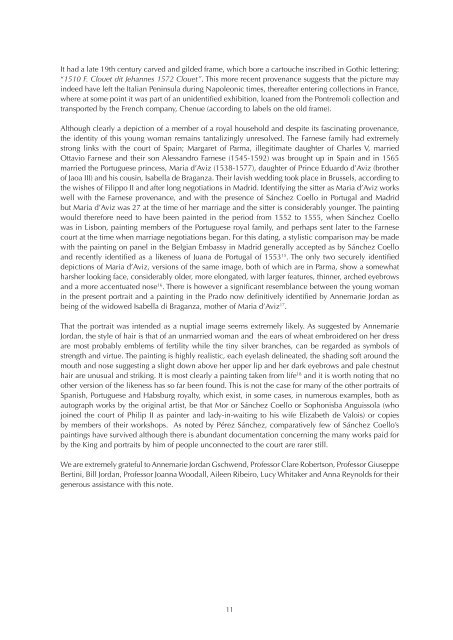Catalogue-2014-Jean-Luc-Baroni
- No tags were found...
You also want an ePaper? Increase the reach of your titles
YUMPU automatically turns print PDFs into web optimized ePapers that Google loves.
It had a late 19th century carved and gilded frame, which bore a cartouche inscribed in Gothic lettering:<br />
“1510 F. Clouet dit Jehannes 1572 Clouet”. This more recent provenance suggests that the picture may<br />
indeed have left the Italian Peninsula during Napoleonic times, thereafter entering collections in France,<br />
where at some point it was part of an unidentified exhibition, loaned from the Pontremoli collection and<br />
transported by the French company, Chenue (according to labels on the old frame).<br />
Although clearly a depiction of a member of a royal household and despite its fascinating provenance,<br />
the identity of this young woman remains tantalizingly unresolved. The Farnese family had extremely<br />
strong links with the court of Spain; Margaret of Parma, illegitimate daughter of Charles V, married<br />
Ottavio Farnese and their son Alessandro Farnese (1545-1592) was brought up in Spain and in 1565<br />
married the Portuguese princess, Maria d’Aviz (1538-1577), daughter of Prince Eduardo d’Aviz (brother<br />
of Jaoa III) and his cousin, Isabella de Braganza. Their lavish wedding took place in Brussels, according to<br />
the wishes of Filippo II and after long negotiations in Madrid. Identifying the sitter as Maria d’Aviz works<br />
well with the Farnese provenance, and with the presence of Sánchez Coello in Portugal and Madrid<br />
but Maria d’Aviz was 27 at the time of her marriage and the sitter is considerably younger. The painting<br />
would therefore need to have been painted in the period from 1552 to 1555, when Sánchez Coello<br />
was in Lisbon, painting members of the Portuguese royal family, and perhaps sent later to the Farnese<br />
court at the time when marriage negotiations began. For this dating, a stylistic comparison may be made<br />
with the painting on panel in the Belgian Embassy in Madrid generally accepted as by Sánchez Coello<br />
and recently identified as a likeness of Juana de Portugal of 1553 15 . The only two securely identified<br />
depictions of Maria d’Aviz, versions of the same image, both of which are in Parma, show a somewhat<br />
harsher looking face, considerably older, more elongated, with larger features, thinner, arched eyebrows<br />
and a more accentuated nose 16 . There is however a significant resemblance between the young woman<br />
in the present portrait and a painting in the Prado now definitively identified by Annemarie Jordan as<br />
being of the widowed Isabella di Braganza, mother of Maria d’Aviz 17 .<br />
That the portrait was intended as a nuptial image seems extremely likely. As suggested by Annemarie<br />
Jordan, the style of hair is that of an unmarried woman and the ears of wheat embroidered on her dress<br />
are most probably emblems of fertility while the tiny silver branches, can be regarded as symbols of<br />
strength and virtue. The painting is highly realistic, each eyelash delineated, the shading soft around the<br />
mouth and nose suggesting a slight down above her upper lip and her dark eyebrows and pale chestnut<br />
hair are unusual and striking. It is most clearly a painting taken from life 18 and it is worth noting that no<br />
other version of the likeness has so far been found. This is not the case for many of the other portraits of<br />
Spanish, Portuguese and Habsburg royalty, which exist, in some cases, in numerous examples, both as<br />
autograph works by the original artist, be that Mor or Sánchez Coello or Sophonisba Anguissola (who<br />
joined the court of Philip II as painter and lady-in-waiting to his wife Elizabeth de Valois) or copies<br />
by members of their workshops. As noted by Pérez Sánchez, comparatively few of Sánchez Coello’s<br />
paintings have survived although there is abundant documentation concerning the many works paid for<br />
by the King and portraits by him of people unconnected to the court are rarer still.<br />
We are extremely grateful to Annemarie Jordan Gschwend, Professor Clare Robertson, Professor Giuseppe<br />
Bertini, Bill Jordan, Professor Joanna Woodall, Aileen Ribeiro, <strong>Luc</strong>y Whitaker and Anna Reynolds for their<br />
generous assistance with this note.<br />
11
















